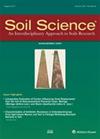Transition to conservation agriculture: how tillage intensity and covering affect soil physical parameters
4区 农林科学
Q2 Agricultural and Biological Sciences
引用次数: 5
Abstract
Abstract. Conservation agriculture (CA) relies on two key practices to improve agricultural sustainability—reduced tillage and cover crop usage. Despite known soil physics benefits (reduced soil compaction and strength, enhanced soil porosity and permeability), inconsistent reports on short-term CA results have limited its adoption in European agroecosystems. To elucidate the short-term effects, a three-year experiment in the low-lying Venetian plain (Northern Italy) was undertaken. Bulk density, penetration resistance, and soil hydraulic measures were used to evaluate results obtained by combining three tillage intensities (conventional tillage (CT), minimum tillage (MT), no tillage (NT)) with three winter soil coverages (bare soil (BS), tillage radish cover crop (TR), winter wheat cover crop (WW)). Among the tillage methods and soil layers, CT, on average, reduced BD (1.42 g cm−3) and PR (1.64 MPa) better in the 0–30 cm tilled layer. Other treatments yielded higher values (+4 % BD and +3.1 % PR) in the same layer. Across the soil profile, reduced tillage coupled with WW improved soil physics even below the tilled layer, as evidenced by root growth-limiting threshold declines (−11 % in BD values > 1.55 g cm−3 and −7 % in PR values > 2.5 MPa). Soil hydraulic measures confirmed this positive behaviour; NT combined with either BS or WW produced a soil saturated conductivity of 2.12 × 10−4 m s−1 (four-fold that of all other treatments). Likewise, sorptivity increased in NT combined with BS versus other treatments (3.64 × 10−4 m s−1 vs an all-treatment average of 7.98 × 10−5 m s−1). Our results suggest that despite some measure declines due to reduced tillage, the strategy enhances soil physics. In the short term, cover crop WW moderately increased physical soil parameters, whereas TR had negligible effects. This study demonstrates that CA effects require monitoring several soil physical parameters.向保护性农业过渡:耕作强度和覆盖对土壤物理参数的影响
摘要保护性农业(CA)依靠两种关键做法来提高农业可持续性:减少耕作和覆盖作物的利用。尽管已知的土壤物理效益(减少土壤压实和强度,提高土壤孔隙度和渗透性),但关于短期CA结果的不一致报告限制了其在欧洲农业生态系统中的采用。为了阐明短期效果,在低洼的威尼斯平原(意大利北部)进行了为期三年的实验。利用容重、抗侵透性和土壤水力指标对3种耕作强度(常规耕作(CT)、最少耕作(MT)、免耕(NT))和3种冬季土壤覆盖(裸土(BS)、耕作萝卜覆盖作物(TR)、冬小麦覆盖作物(WW))相结合的结果进行评价。在不同的耕作方式和土层中,CT在0 ~ 30 cm的耕作层平均降低了1.42 g cm−3的BD和1.64 MPa的PR。其他处理在同一层中获得更高的值(+ 4% BD和+ 3.1% PR)。在整个土壤剖面上,减少耕作加上WW改善了土壤物理特性,甚至在耕作层以下,根系生长限制阈值下降(BD值> 1.55 g cm - 3时为- 11%,PR值> 2.5 MPa时为- 7%)。土壤水力测量证实了这种积极的行为;NT与BS或WW结合,土壤饱和电导率为2.12 × 10−4 m s−1(是所有其他处理的4倍)。同样,与其他处理相比,NT联合BS的吸附性增加(3.64 × 10−4 m s−1,而所有处理的平均值为7.98 × 10−5 m s−1)。我们的研究结果表明,尽管由于减少耕作而导致一些措施下降,但该策略增强了土壤物理特性。在短期内,覆盖作物WW适度增加了土壤物理参数,而TR的影响可以忽略不计。本研究表明,CA效应需要监测多个土壤物理参数。
本文章由计算机程序翻译,如有差异,请以英文原文为准。
求助全文
约1分钟内获得全文
求助全文
来源期刊

Soil Science
农林科学-土壤科学
CiteScore
2.70
自引率
0.00%
发文量
0
审稿时长
4.4 months
期刊介绍:
Cessation.Soil Science satisfies the professional needs of all scientists and laboratory personnel involved in soil and plant research by publishing primary research reports and critical reviews of basic and applied soil science, especially as it relates to soil and plant studies and general environmental soil science.
Each month, Soil Science presents authoritative research articles from an impressive array of discipline: soil chemistry and biochemistry, physics, fertility and nutrition, soil genesis and morphology, soil microbiology and mineralogy. Of immediate relevance to soil scientists-both industrial and academic-this unique publication also has long-range value for agronomists and environmental scientists.
 求助内容:
求助内容: 应助结果提醒方式:
应助结果提醒方式:


